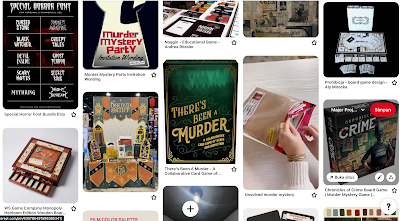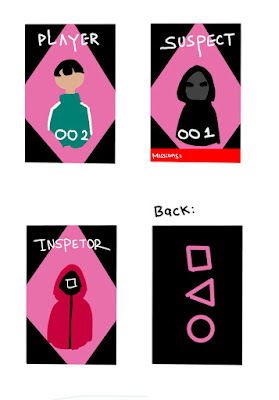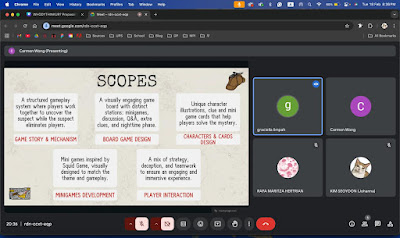Major Project 1 | Task 1: Proposal Development
Task 1: Proposal Development
Week 01 - Week 03 | 04.02.2025 - 19.02.2025
Rafa Maritza Hertrian [0364958]
Bachelor of Design (Honours) Creative Media/ Taylor's University
[PRJ64904 Major Project 1]
Bachelor of Design (Honours) Creative Media/ Taylor's University
[PRJ64904 Major Project 1]
Links:
INSTRUCTIONS
PROCESS
1.1. Week 1In the start of the class, we were instructed to divide into groups of 4 to work on the project.
My group members:
- Graciella Limpah
- Wong Jia Yi Carmen
- Kim Seoyoon
We came up with two ideas from the discussion: a Valentine-themed game,
and a Squid Game-inspired game. We decided to go for the squid game-themed
board game since the Squid Game series is currently trending, and a new
season will come.
After that, we go through Pinterest to collect visual references for the
board game. This was to ensure that everyone is on the same
page.

Figure 1.2 Inspiration Board

Figure 1.3 Inspiration Board
2.1 Week 2
In class, we discussed how the game would work. We came up with an idea
to mix the Monopoly and Werewolf systems while also incorporating
traditional Korean games. We decided to add the Werewolf system because in
season 1 and season 2 of the series, the Frontman plays among the players.
We really like this idea, so we want to put an imposter among the players.
For the board style, we used a Monopoly reference.

Figure 2.2 Rough Idea of the Game
At this point, we realized we needed a name for the game. We wanted the game to center around the existence of the suspect within the players. Then, Carmen came up with the idea of "Whodoythinkur" which stands for "Who do you think you are".



2.2 Initial Game System:
Roles:
-
Inspector: one person that don't actually get on the game but controls
how the game plays. (They will not win nor lose)
-
Suspect: one person that will play along with the players pretending to
be one of them and killing the people in the night. (Will win if the
suspect succeeds in killing most of the players or reaches the end of
the game)
-
Players: players will play and will try to figure out the suspect.
(they will win by reaching the end of the game or figuring out who the
suspect is)
Board System: To use this board game, the players will start the game from
the 'start' and also finish the game in the same block. To move, the players
will have to play Ddakji and keep playing until they win one time.
Board Items:
-
Minigames: The players will play either Red Light Green Light, Dalgona,
Gonggi, Spiraling top
-
QnA: The player can choose someone else to ask one question about their
traits
-
Clue/hint: The inspector will describe one trait of the suspect to the
player.
-
Night time: Everyone will close their eyes, and the killer will be
summoned by the inspector to kill one person among the players. The
player chosen will get eliminated.
-
Discussion: This is the time when the players have to guess who the
suspect is. If they get the person, the person chosen will be
eliminated.
-
Jail: In jail time, the player will be skipped one round of the
game.
Cards:
-
Cards for players: show a character with specific traits
-
Suspect card: Kill or no kill
-
Cards for Extra Minigames.
2.3 Board Sketches:
Below is the sketch of the board game that Carmen created out of our
discussion:

Figure 2.3.1 Board Sketch ver 1
After seeing this design, we discussed more and decided on some changes. We
decided that the minigames will be chosen by drawing a minigame card,
meaning that we have to also make a minigame deck. Secondly, we thought that
using Ddakji as a tool might be too hard and will make the game
unnecessarily long. Hence, we come up with the idea that the players will
move using a two-sided coin. One side is to walk 1 step and the other side
is to walk 2 steps. The reason why we don't just use dice is because the
game might not flow smoothly. After all, there might be too many steps
skipped.


|
|
|
2.4 Card Sketches:
From that I created the sketch for the role cards. I got the idea that the
roles would be inspired by the characters in Squid Game:

Figure 2.4.1 Role Card Sketch
-
Players: will be wearing the player uniform in Squid Game.
-
Inspector: will be the pink guard since in the series, the pink guards
are the ones running the game.
-
Suspect: will be the frontman designed car because in the series,
frontman plays among the players.

Here are some other card concepts created by Carmen:
The player card will have traits that will be specified in each
cards, players will have to explain their player
characteristics.
Here are some other card concepts created by Carmen:
The player card will have traits that will be specified in each
cards, players will have to explain their player
characteristics.

Figure 2.4.2 Player card concept

These are the cards connected with the suspect. At first I was
confused on how these cards will be applied because if the cards
are given to the suspect then the other players can see who got
additional cards. Me and the others discussed if the
instructions can just be placed inside the inspector card or let
the inspector hold the cards.

Figure 2.4.3 Suspect cards concept

These are the cards for the players, they will blind pick
this (I forgot how the players will get this card in the
initial idea).
These are the cards for the players, they will blind pick
this (I forgot how the players will get this card in the
initial idea).

Figure 2.4.4 Heal cards concept

These are other card concepts :

Figure 2.4.5 Other cards

And finally, this is the card for minigames. The instructions will
be provided on the inside of the card.

Figure 2.4.6 Minigame cards sketch

3.1 Week 3
After making the initial design, we proceeded to create the
proposal as instructed. We divided our tasks:
1. Introduction (Carmen)
2. Project Objectives (Graciella)
3. Audience Research (Rafa)
4. Existing Media Analysis(Jo)
5. Ideation (Together)
6. Development (Together)
After dividing the tasks, we made a Google doc to compile the
information we got based on the task we had.
Figure 3.1.1
3.2 Proposal Development:
1. Introduction (Carmen)
2. Project Objectives (Graciella)
3. Audience Research (Rafa)
4. Existing Media Analysis(Jo)
5. Ideation (Together)
6. Development (Together)
We thought we needed to finish the proposal but it turns out that
we only needed to do until project objectives. Hence we deducted
the thing we already made.
The day before the presentation, we decided to practice our
parts from an online meeting. The next day we presented the proposal in the class as we
practiced.
After presenting our proposal, we got several feedback from our
classmates and our lecturer. During the class, we realized that we
still need to work on the game system again by playing the game so
that we can see the flaws. Ms Vitiya also said that we still need to
work on our problem statement because it is not convincing enough.
She also reminded us to do market research for the target
audience section. Hence, we discussed that we should do an online
survey on our project.
FEEDBACK
Week 1
After my group mates and I consulted our topics, Ms Vitiya said
that both the squid game and the Valentine board game idea are
good, but we need to ensure that the project is doable even
though we work individually. She also suggested that we could
make different versions of the board game if there were multiple
ideas.
Week 1
After my group mates and I consulted our topics, Ms Vitiya said
that both the squid game and the Valentine board game idea are
good, but we need to ensure that the project is doable even
though we work individually. She also suggested that we could
make different versions of the board game if there were multiple
ideas.
Week 2
We explained the rough idea of the game system we created to Ms
Vitiya. She commented that we should try to make the prototype
of the game, and try playing it so it is easier to see if there
are any flaws in the game system.
Week 2
We explained the rough idea of the game system we created to Ms
Vitiya. She commented that we should try to make the prototype
of the game, and try playing it so it is easier to see if there
are any flaws in the game system.
Week 3
In class, we presented our proposal for our game and got several
comments. The problem statement of our project needs to be
improved. Ms Vitiya also thinks that the game length might be
too short, so we were suggested to add more steps to the
board. We were also suggested to start doing a survey
for our target audience.
Week 3
In class, we presented our proposal for our game and got several
comments. The problem statement of our project needs to be
improved. Ms Vitiya also thinks that the game length might be
too short, so we were suggested to add more steps to the
board. We were also suggested to start doing a survey
for our target audience.
SUBMISSION
Proposal Development
REFLECTION
Building the idea for this project was a very fun experience because I got to work on something that I am interested in as a project. I was very into the series Squid Game nowadays, so bringing it into a board game has really motivated me to continue doing this work. I am also glad that my teammates and I have the same opinions on how the games should run. Working together with other people for a complete project is a rare opportunity, so I was excited to learn new skills from my teammates.



Comments
Post a Comment